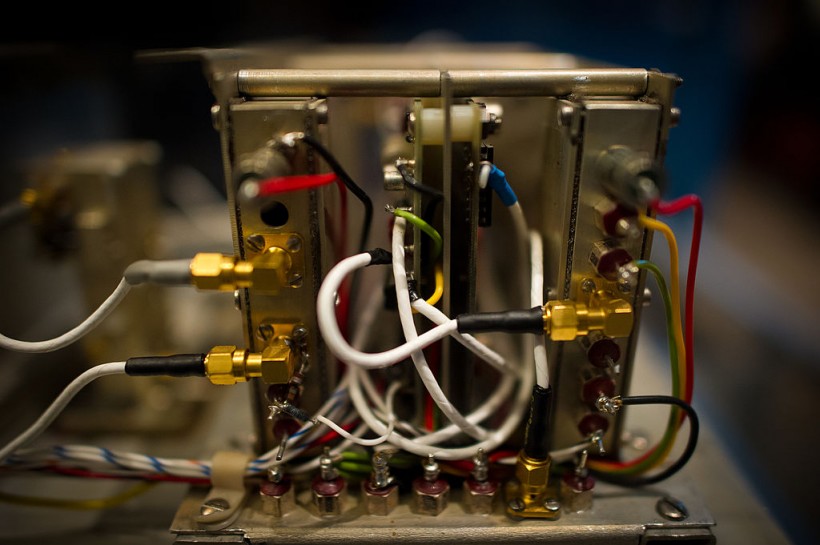Researchers are using atomic clocks in a laboratory to explore profound cosmic puzzles, such as the properties of dark matter. This collaborative project, involving the University of Sussex and the UK's National Physical Laboratory (NPL), harnesses the remarkable precision of these clocks to seek previously unidentified ultra-light particles. In doing so, they aim to make cosmology and astrophysics more accessible and tangible.

The interior of a 1970 "atomic clock" designed to work in the space, exposed at the "Time and navigation" exhibition at the Smithsonian National Air and Space Museum in Washington, April 10, 2013.
What Are Atomic Clocks?
Atomic clocks utilize the resonance frequencies of atoms as their resonators, regulated by the microwave electromagnetic radiation emitted or absorbed during quantum transitions. Atoms, such as cesium-133, resonate at highly consistent frequencies, with cesium-133 oscillating at precisely 9,192,631,770 cycles per second.
This unmatched precision contrasts with quartz clocks, which rely on quartz crystals with manufacturing tolerances and susceptibility to temperature variations. Atomic clocks' uniform atomic resonance frequencies make them exceptionally accurate timekeepers.
In space navigation, time is crucial for determining a spacecraft's distance from Earth. Atomic clocks, unlike standard quartz crystal clocks, provide the precision and stability needed for this task. They achieve this by using atoms, such as mercury atoms in the Deep Space Atomic Clock, whose energy levels are precise and consistent throughout the universe.
The Deep Space Atomic Clock represents a significant advancement in space navigation, offering unparalleled stability and precision by utilizing atoms and unique ion-trap technology. This innovation has the potential to transform how spacecraft navigate, particularly on missions to distant celestial bodies. Now, scientists want to use atomic clocks to detect dark matter in the universe.
READ ALSO: New Atomic Clock Is As Small as Postage Stamp but Not As Accurate as Its Predecessors
Finding Dark Matter Using Atomic Clocks
Xavier Calmet, a professor of physics at the University of Sussex, highlights that deviations from the known laws of physics represent a "breakdown in physics" and imply the existence of new physics beyond current understanding.
This new physics could potentially provide explanations for enigmatic phenomena like dark matter, which remains unexplained within the confines of the Standard Model of particle physics.
Established physics laws dictate that clocks should maintain a constant ticking rate, but deviations from the Standard Model could cause minor variations in atomic energy levels, affecting clock precision. This challenge is addressed using atomic clocks, which bring cosmology and astrophysics to terrestrial settings, enabling investigations into ultra-light particles potentially linked to dark matter.
Atomic clocks operate by monitoring atoms oscillating between energy states at consistent resonance frequencies, ensuring remarkable accuracy. These precise instruments can detect subtle changes in fundamental constants caused by ultra-light dark matter particles, opening new possibilities in physics research.
Furthermore, the technique may extend to probing other cosmic mysteries, including dark energy, which propels the universe's accelerated expansion. While dark energy is often attributed to the cosmological constant, atomic clocks might still offer insights by being sensitive to potential ultra-light particles associated with dark energy waves.
Although the clocks have yet to uncover new physics, they've introduced a novel theoretical framework and model-independent constraints on physics beyond the standard model, forging an interdisciplinary field merging atomic, molecular, optical physics with traditional particle physics.
These groundbreaking developments are awaiting publication in the New Journal of Physics.
RELATED ARTICLE: Scientists Say Atomic Clocks Near Sun May Help Find Dark Matter, New Physics
Check out more news and information on Space in Science Times.




![Earth's Quasi-Moon Kamo‘oalewa Could Originate From Lunar Surface Not Asteroid Belt [Study]](https://1721181113.rsc.cdn77.org/data/thumbs/full/53275/89/56/50/40/earths-quasi-moon-kamo-oalewa-could-originate-from-lunar-surface-not-asteroid-belt-study.png)









